We’ve just passed the Feast of the Epiphany and have contemplated the Magi in their search for a Child who could bring salvation. At times, when I consider these ancient travelers from the East I find my thoughts turning to the bearded, chanting, ornately vested priests of the Eastern churches who swing their tinkling thuribles full of incense with an energy and commitment that makes you think they could be offering that incense to a Child in a manger.
Many Roman Catholic priests use incense too, especially on feasts, but I really wish they would use it more—and not just more, but more enthusiastically, like their Eastern brothers.
I love incense, and I think it’s important in ways that many people seem to have forgotten. But before we get into that, I’m reminded of an incident in my childhood that no one in my family can forget.
Out of the Mouths of Babes
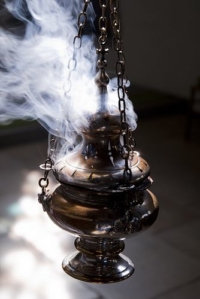 When I was a kid, my parents would sometimes surprise their six children by marching us all the way to the front pew for Mass. I think it was their method of unruly child control – although I’m going to take the fifth on my own participation in any activities that needed regulating.
When I was a kid, my parents would sometimes surprise their six children by marching us all the way to the front pew for Mass. I think it was their method of unruly child control – although I’m going to take the fifth on my own participation in any activities that needed regulating.
But I will say this: I wasn’t the worst offender in my family. One Christmas, my little brother, standing on the kneeler (in the front pew), got more than a whiff of the copious incense the priest was using. He made the kind of face children make when they smell or taste something truly horrible and promptly intoned for everyone to hear: “Pew – what stinks? Open the window!”
I didn’t think the smell was as awful as my brother did, but it wasn’t as appealing to me then as it is now. As an adult, I can only exclaim: What a wonderful, aromatic blessing incense is to the Christian Church!
Liturgical Incense is an Ancient Tradition
Let’s consider for a moment the beauty and wonder of incense. Did you know that the Judeo-Christian tradition, dating back at least to the time when David was writing the Psalms (~1000 BC), has an unbroken record of incense use in worship?
Incense was in constant use in the Temple in Jerusalem. So it makes sense that the early Christians, who were all Jews, would immediately import incense into their own rites, which is exactly what they did, and there it remains today.
The Cloud–Prayer Metaphor
But what’s the point of incense? Think for a moment about how incense looks at Mass. Imagine the smoke billowing out of a thurible. Imagine it wafting around the altar and then slowly rising and rising until it can no longer be seen. Isn’t that exactly what we hope our prayers will do?
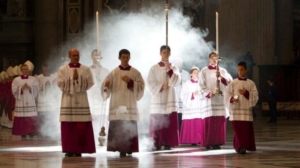 Here’s how Psalm 141 puts it: “Let my prayer be incense before you, my uplifted hands an evening offering.” And this line speaks for all of ancient Judaism and for the Church throughout every moment of its existence.
Here’s how Psalm 141 puts it: “Let my prayer be incense before you, my uplifted hands an evening offering.” And this line speaks for all of ancient Judaism and for the Church throughout every moment of its existence.
Not only that, there are even two stunning passages in the Book of Revelation that show the angels mixing the prayers of the faithful with the spiritual gifts on the heavenly altar of incense (Revelation 5:8, 8:3-4). It is amazing to think that Angels have their own incense!
So, the use of incense is not some antiquated tradition that accomplishes nothing more than setting off the occasional smoke alarm in church (which I’ve also seen happen). Along with King David and the angels of Revelation, we can find in it a perfect symbol for prayer—for our prayers, the ones we hope are heard by God.
And because it is such a perfect and ancient symbol, the Church reserves the use of incense for one purpose: the praise and glory of Almighty God.
Deeper Meanings and Purposes
But a real symbol is always multidimensional, so let’s touch on just three of the dimensions that incense can open up for us.
- Engagement of Our Senses
St. Thomas Aquinas taught that angels get their knowledge directly from God while humans must gain our knowledge of the world through the senses. That means: everything we know, we’ve experienced in some tangible way.
The sense of smell is not often thought of as a pathway to knowledge, but it vivifies us and provides us with a type knowledge that is different from the book type. In a religious context, it gives us an experience of divine sweetness, a pleasant engagement of our olfactory sense in the act of prayer, and at times a mystical sense of the grace that comes through worship. In my experience, it’s hard to claim that “Mass is boring” when incense is involved.
- A Unifying Force
Incense (as does all smoke and gas) pervades the air, so when a priest uses incense in church, its sweet aroma fills the entire space and may linger there for hours. Everyone in that space smells it, everyone finds himself engulfed in it, and everyone is brought together by its aroma. There are no strangers in that cloud. It represents and helps form a unity of faith and prayer.
The sense of being engulfed by a cloud of incense might remind us that our ancestors in faith, the Israelites, were led by a mysterious pillar of cloud in their travels to the Promised Land. This cloud would engulf them and their tent of meeting at night, a sure sign that their God was present to them—a sure sign that their God was enfolding them in His sheltering arms.
- The Power of Christian Example
St. Paul says that we must be a “pleasing aroma of Christ for God among those who are being saved and among those who are perishing” (2 Corinthians 2:15). St. Paul would have been very familiar with the smell and use of incense from the Jewish rites in the Temple and synagogue. His metaphor to the Corinthians exhorted them to live the life of faith to the fullest.
Isn’t it true that the power of a good example of a saintly soul lingers in the heart and soul like incense when we see it displayed clearly? The holy example (aroma) can also be a wake-up call to unbelievers, “those who are perishing.”
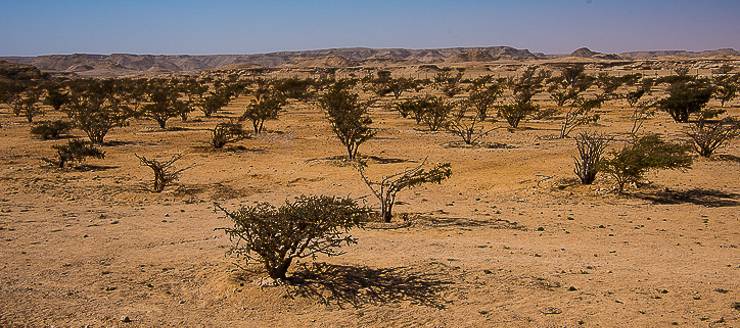
The Blessed Fruit of the Earth
 Do you ever wonder where (earthly) incense comes from – or even what it is?
Do you ever wonder where (earthly) incense comes from – or even what it is?
The short answer is that incense is the blessed fruit of our earth. A good percentage of it (the kind we use in church, anyway) comes from the oily resin that exudes from a particular type of tree in the Mideast that belongs to the Boswellia sacra family. Notice the identifier “sacra” (sacred).
These trees generally grow in the country of Oman in the Dhofar desert and various other places in the Middle East and the Horn of Africa (e.g., Somalia). One writer has noted that the Dhofar desert is one of the toughest places to live on earth – its landscape resembles the surface of Mars!
These trees, harvested by Bedouins, form the basis of an enormous industry (for perfume as well as liturgical incense.) They are usually found in copses growing on hereditary property and are jealously guarded because of their precious yield.
Christian iconography has identified this fruit of the Boswellia sacra trees as the frankincense the Magi offered to the Christ Child on the feast of the Epiphany.
To harvest it, cultivators cut the bark of the trees, which slowly oozes out its resin over the period of a few weeks. This substance is set out to dry for a week in the hot desert sun and then broken or cut into pieces for packaging and sale. In many cases, the pieces form natural droplets in the form of “desert teardrops” that need no cutting. Each tree is harvested twice a year and then it lies fallow for one year.
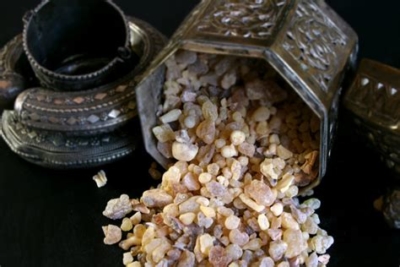 All that may sound exotic and foreign but every altar boy who ever served at Christmas Mass remembers handing the priest the vessel of incense at the altar and watching him scoop those precious kernels of incense onto the burning coals inside the thurible (=incenser), which produces the sweet scent.
All that may sound exotic and foreign but every altar boy who ever served at Christmas Mass remembers handing the priest the vessel of incense at the altar and watching him scoop those precious kernels of incense onto the burning coals inside the thurible (=incenser), which produces the sweet scent.
Also, there is another Middle Eastern tree of the Commiphora family that produces myrrh, one of the other gifts of the Magi.
The product of the myrrh trees comes out in a greater percentage of oily substance (equally aromatic), so it is gathered in its liquid state as an oil of precious quality rather than as a something to be dried and burned to give off its aroma.
Oh. One last question: Why does holy incense smell so sweet, mysterious, and wonderful? You’ll have to ask God that question. It’s part of His beautiful world that never stops communicating grace to us through its sacred windows.
———-
[This article is a reproduction of the Sacred Windows Email Newsletter of 01/09/22, so it does not end with the regular Soul Work section. Please visit our Newsletter Archives.]

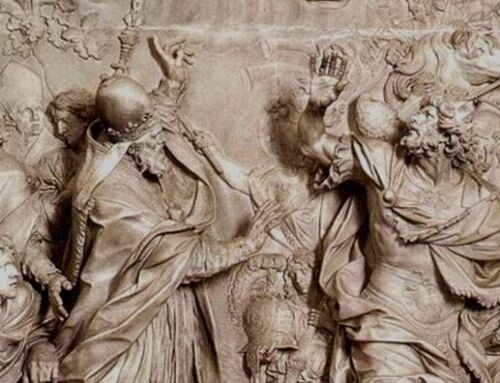
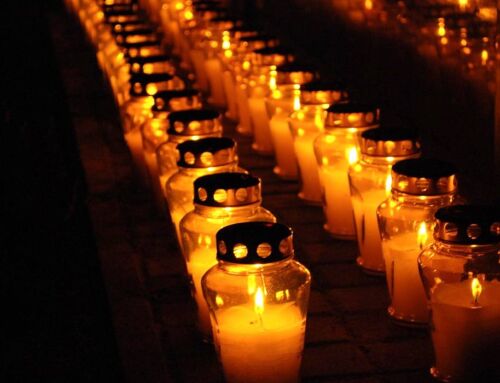
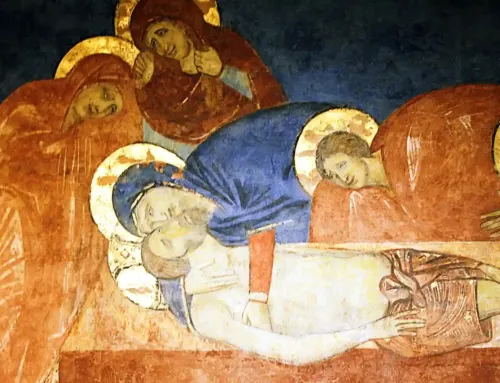
Leave A Comment